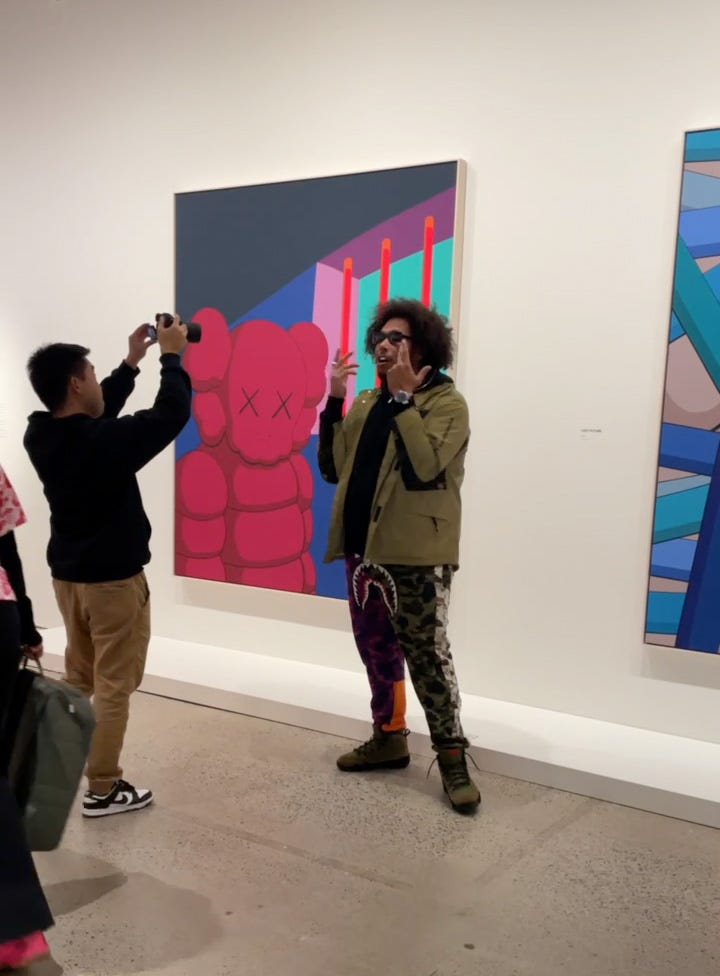What do you want from visual art?
We criticize visual art for striving after what we criticize other art for lacking.
I recently slipped into a rage bait vortex of content creators who go to contemporary exhibitions to shit on the art. Perhaps you’ve seen this. They film a pile of garbage in a white room, then flip the camera and say, see now look, this is what modern art has become. Woke faux intellectuals, rich people, blank canvasses, tax shelters, circle jerk, illuminati, etc. Most commenters laugh and say good riddance to art. The art loyalists open their lengthy rebuttals with first of all, this is contemporary art not modern art which is so annoying that you don’t read any further. Trolls find a way to feast on the earnestness of any well-argued points. Such engagement massively outweighs the handful of 🔥 and 👏🏽 comments in the gallery’s install shot carousel. Contemporary art is served to the masses on social platforms often through a lens of ridicule.
This content exploits the very real challenge contemporary visual art faces in asserting itself through the mediation of screens, which strip it of often necessary context. We exist in a moment when context is rarely desired, where the success of an art project is measured (by many) for its ability to immerse and tidily resolve in as little time as possible. I wrote, in a past letter, that visual artists should care more about immersing viewers and rely less on the project’s stated purpose, but that’s not to say I want art to be made digestible for those who bring nothing to it. If the content creators from paragraph 1, who have already made up their minds before stepping into the gallery, continue to feel excluded from visual art, I’m not convinced that the art world is worse off for it.
That’s not to say I don’t sympathize with their and their follower’s grievances. For the love of a sweeping statement, I’ll go ahead and say that of the mainstream contemporary art forms, visual art is the one that’s least willing to adhere to the demands of viewers and the least willing to meet people where they are. Many people perceive even middlebrow art as being too academic, intellectual, ambiguous, or self-obsessed to be genuinely in touch with society; it exists largely for the sake of itself. I think this assessment is valid.
On the surface, to agree with such a claim feels like a fatal blow to art. But then you ponder the aforementioned qualities: academic, intellectual, ambiguous (searching), self-obsessed — isn’t that exactly how you want your art club to be? This club formed around people who are… obsessed with art. Most of whom would pursue it regardless of the “market” that latched onto it. It’s not the art club’s fault that it appeals to an outsized number of hot / rich / famous people who may or may not care about art. It would be foolish not to welcome this cohort with open arms. The vast majority in the club, however, the worker bees of the art world, care a lot about the actual art. They are not cool and exclusive, they are academic and nerdy and would probably be delighted if asked about their weird project at your next dinner party (though their answer might be annoying).
Contemporary visual art has plenty of issues. But when we look to the other mainstream art industries for guidance, perhaps we realize that it’s not in as bad of shape as it's made out to be — at least philosophically. Here are some cases for why.
*Note: I’m largely omitting the literary publishing industry as a reference because I’m a wee baby about to enter it and manifesting perfection. It’s my newsletter I’ll be delusional if I want to.*
Visual art is OK with making you work.
Relative to the rampant dumbing down of film and TV thanks to overlords opting for lazy recycling over original content, contemporary art’s comfort in making you labour to understand it, and not caring if you don’t, might be seen as a mark of integrity which survived through to the institutional level. Artists are making art for themselves and their colleagues, dialoguing with each other through projects which are often difficult to access as a result. The work can, at times, feel tone deaf and circular, but the general process serves to elevate artistic practice. Unlike three quarters of Netflix slop, it wasn’t designed as background noise for your scrolling comfort.
Commercial galleries as power brokers are far from perfect, but they’re good.
Relative to the gouging of artists which occurs at the hands of Spotify and other music streamers, the commercial galleries (who are the primary brokers) of the art world feel like angels. Yes, they take a chunky commission on sales (~50%), and some have reputations for withholding funds from artists and other shady behaviours, but many, many gallerists are beloved by their artists with whom they have long standing and mutually beneficial relationships. Most gallerists are not living the lavish lifestyle their Instagram feeds might suggest; they are cobbling grant (or daddy’s) funds together and breaking even on costs, often sustaining themselves on passion. Their functionality is more akin to niche, indie labels or collectives doing whatever they can to elevate their cohort. There are monopolistic forces at the top, no doubt, but nowhere near what exists in music, film, TV.
The pricing model sucks for us, but arts workers need to get paid.
Contrary to the race-to-the-bottom price models of streamers, visual art has the opposite issue: gallerists prop up prices so as to not undermine their collectors’ portfolios, to the detriment of artists who aren’t selling due to said prices. Also because galleries are not low-cost operations — they ship delicate art to fairs around the globe and pay rent in the most expensive cities. Yes, there are problems with this: it sucks that few can buy art except for the rich; gallery pricing can feel arbitrary and exploitative; there is a huge revenue gap between haves and have-nots artists. But on the flip side, there remains an expectation that even mid-tier or emerging artists should respect and uphold a price point that, if they were selling, would award them a living wage. The price point is delusional for many artists, but at least they are aspiring in the right direction. Those who complain about the exploitation of artists in other industries while complaining about the price point of visual art need to reconcile what it means to give an artist a living wage.
Public exhibition is the gold standard.
Per the previous point, you and I probably won’t get to own the art of highly successful artists. But their work almost always passes through the hands of commercial galleries and institutions who adhere, often with great care, to a tradition of public exhibition which allows anyone to experience the art. During these exhibitions, sales are often not the primary metric of success. In many cases, top-selling artists subsidize exhibitions with artistic merit but low commercial viability (e.g. a multimedia installations). Quality and originality of programming continues to be a key metric in the perception of institutions and galleries. And the industry demands people to leave home and see the work in real life. These standards could be considered miracles in 2025.
Art objects will remain objects.
Basically all the shittiness in other art industries relative to which visual art feels OK comes at the hands of streamers. So that’s what I’ll close on. The majority of visual art objects cannot and will not have their experiences mediated by digital platforms. Other popular art forms—music, film, literature—can be parsed onto the screen with minor loss of experiential quality. Sure, nothing beats a concert or a cinema with a buzzing crowd, but we can throw on Tiny Desk or Prime Video and correctly claim to have experienced the art. The same could even be said for theatre productions, I would imagine, although I hope this isn’t happening.
Conversely, it is almost impossible for me to feel that I’ve experienced visual art (let alone write about it) without having viewed the work in person. AR tools that let you tour an exhibition from your laptop are awful and I don’t see them improving anytime soon. Few people would claim to have experienced an artist’s work after scrolling their feed, or claim to have experienced an exhibition from the gallery’s installation shots. This might be an argument for art’s irrelevance (it can’t remain competitive in a culture dominated by screens), but I disagree. As I write this, my smart TV plays a screensaver of Google Arts & Culture, rotating pics of iconic artworks, none of which I could ever claimed to have “experienced” — and thank god for that. It's on my bucket list to see The Scream at the National Museum in Oslo.
TL;DR
If your criticisms towards the state of contemporary visual art hinge upon it being an inferior experience via digital mediation, or because it feels like an overly challenging, academic, or self-obsessed club, consider the possibility that these are its best qualities. It sustains itself on its own interest, stays connected through public gathering, and doesn’t pay much attention to how it is perceived from afar. That’s how the best clubs work.
Here are some recent engagements with my local catdom xoxo








